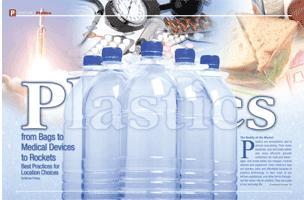
 The Reality of the Market
The Reality of the Market
Plastics are everywhere and in almost everything. They make airplanes, cars and boats lighter and more efficient, provide containers for food and beverages, and create better, but cheaper, medical devices and equipment. Even children’s toys are sturdier, safer and affordable because of plastics technology. In fact, most of our kitchen appliances, and other items throughout the home, rely on plastics. They are a part of our everyday life.
The magnitude of the industry is significant in terms of the economy, jobs, wages, capital investment and new capital circulation in the local economy and in global trade benefits. Recent statistics include:
Over $350 billion of plastics goods shipped in a year
Directly employ over 1.5 million people (the multiplier/spinoff in indirect and induced jobs is at least three times this number)
Over 19,000 operating facilities industry-wide.
Global Competition
According to the Freedonia Group, a plastics industry research group in Cleveland, the demand for certain plastics will continue to see growth in the U.S. (frozen and refrigerated food containers, medical devices, plastic bags, etc.). Other studies also show growth in Central and Eastern Europe, Asia and other areas. China, with its overall industrial boom and double-digit economic growth, continues to have a strong thirst for plastics and a dedicated effort to produce within its borders for its own consumption, as well as for exporting.
Overseas firms are continuing their aggressive pursuit of American markets, and similar to global automakers (Toyota, Nissen, Mercedes, etc.), are seeking opportunities to build and expand operations in the U.S. Firms, for example, from Japan, India, Europe and other locations, are finding opportunities and right fits in the U.S. Where the large producers go, so will the other firms that supply the producers and the other companies that use their products.
The good news should be obvious to the plastics industries at large…studies show the U.S. will continue to be positioned to grow opportunities onshore such as packaging, particularly for food and beverages, as well as for pharmaceuticals. The Freedonia Group found that U.S. beverage container demand will continue to grow to over $20 billion within a few years.
The potential impact for the industry is significant. Recognizing opportunities for the best places to locate a business and seizing upon them will continue to be the best avenue to success. From a site selection reality, it makes good sense, or more aptly put, a business imperative, to be close to a geographic network of suppliers and vendors. There are communities across the U.S. that have a strong focus on manufacturing (and the plastics industry in particular), which suggests they have a good understanding of the services and support they need to provide to continue to nurture the industry.
The best method to learn which locations would be the best fit is directly from other companies operating in the community, as well as from trade industry associations, publications and site selectors. Additionally, states and communities should have extensive Web sites managed through their economic development offices that give a company a good indication of their priority industry clusters.
Drivers for Growth
The major growth domestically is in the smaller, faster, higher value and lighter products. Locating close to U.S. customer markets is the key driver, along with ample existing building space, land, available talent, reasonable costs of doing business, public incentives and business-friendly communities.
The American technology and mastery in best business practices will continue to provide an advantage in the higher value and more advanced products. The good news is that the industry will continue to improve to create better and more cost-effective products. Lean manufacturing principles continue to be a staple of the industry.
Due Diligence
A company looking to relocate should first determine their particular “Factors for Success.” Then, when performing due diligence and before investing significant capital, the process should always include a list of potential site locations. The process of the intense search begins to eliminate communities that do not meet the “Factors.”
Some of the factors of success in the plastics industry are also standard for other manufacturing companies. However, several unique requirements for this industry include:
Available specialized talent at reasonable wages
Ability to retain the talent
The regulatory environment
Cost and reliability of power
Proximity to an international airport with many flight options
Good road transportation network
Availability of research and development institutes specializing in plastics technology.
Factors for Success
The key factors in site selection are ever-evolving, but the strategy should always be for long-term solutions, not just short-term gain. The upfront and focus diligence will lead to long-term success.
Even though no one location can be all things to all companies, the corporation should closely look to communities with leaders who have identified their industry as a priority and clearly articulate their understanding of the needs associated with their industry and how to best develop the cluster approach to support that industry’s needs. The company should also look for a community that has a strategic plan for developing and nurturing the special needs of the industry and a willingness to create an environment for similar companies to support one another.
The corporation should also look for a community that invests in themselves through investing in the infrastructure required and expected by the industry. A word of caution, one might deduce that if there are similar companies in a particular community, then it must be the best place. However, it may no longer be as attractive since it may be oversaturated in a difficult employee recruitment market.
When the company evaluates any community, it should do so based on their established requirements, but also evaluate these requirements relative to other communities’ assets and infrastructure. Public incentives are considered a community asset that can be shared with a company with the understanding it will contribute back many times over. As one city manager in the southwest U.S. stated, “We ought to be willing to invest in companies that are willing to invest in us.”
The ground game can make all the difference. Visiting communities has become the essential part of the process. There have been numerous occasions where the site location decision matrix evaluates communities high or low only to change and reprioritize once the team gets on the ground, views the community up close and meets the key people. Company officials must personally visit each location and not rely solely on site selectors or real estate brokers. These consultants are an important part of the team; however companies should never rely on outside council to make the selection.
When visiting a potential location, the team needs to meet more than just the economic development and elected officials. They should insist on meeting other companies operating in the community. Meet separately with business leaders without the public officials. Candid discussions should involve an available and realized workforce, regulatory environment, cost of doing business and perceived business friendliness with an appreciation for the manufacturing sector. Always ask, “If you had it to do over again, would you choose this community? Why or why not?” There is no substitute for face-to-face discussions with other businesses.
Case in point, we were recently involved in a project where outside labor and government studies seemed to indicate the appropriate wages to best recruit and retain employees. However, after meeting with similar companies in the potential community, the reality was a different story. The communication from the business human resources and site management team strongly suggested that to best compete for employees in the market the wages would need to be 10 to 20 percent above what the studies indicated. As a result, the company chose a site elsewhere.
Costs and Incentives
Costs of doing business and incentives can become key location discriminators when selecting a site. Cost is determined by many factors: proximity to markets, transportation (truck, highway and air service that is reliable and convenient, with flight frequency options especially for the lighter weight plastics that can be delivered “Just In Time”), utility and power expenses, availability of existing buildings and site-ready land at reasonable costs, and sufficient and reliable talent pool (work force) at reasonable wages.
Incentives that lower the cost of business and potentially mitigate some of the financial and other risks often become key discriminators. Some industries will contend that if a community is offering incentives, there must bea negative reason why. However, it is a positive message that the community covets the company and they understand the nature of business. “The sole purpose of the public corporation is to increase shareholder wealth” while in reality also increasing community wealth.
The right mix of the corporate “must haves” with the right mix of community assets and incentives will create the right formula for success for all involved.
Other Key Considerations
The plastics industry has some standard expectations and requirements that must be in place before a respective community is able to capture and grow these high-salary companies. Some of the community infrastructure factors that should be available are as follows:
Expected Considerations:
Existing reasonably priced buildings of sufficient size
Sufficient land available (shovel-ready)
Complete utility- and power-ready support with ample backup
Sufficient transportation networks
Sufficient physical infrastructure support
Excellent educational institutions
Available workforce at reasonable wages.
Other Incentives:
Tax credits, abatements, exemptions, etc. for corporate income taxes, property taxes, sales/use taxes, impact fees, etc.
Training Grants
Cash Grants
Expedited permitting
Swift environmental approvals
Reasonable energy costs.
All of the above incentives are considered “high value,” and if a community does not have the extensive incentive portfolio, then they should no longer be considered. However, remember many other factors determine cost, as described earlier, but hard and soft incentives can be key discriminators.
Danger on the Horizon
The political process can adversely or positively affect the site location decisions. As has been said, “The government will always do something to you or something for you, either good or bad, but will always do something.” There are many examples of environmental groups sidetracking, or stopping, a project. The political environment is ever changing and if the perception, or reality, is that the plastics industry is not welcome due to exhaustive court cases, delayed projects or political action or inaction, then other pastures should be pursued.
Also, potential environmental obstacles and sense of the appetite in the community for a perceived chemical-related plastics company are critical business-friendly factors. Plastics companies are seizing upon the earth-friendly movement and responding to the Green initiatives through recycling efforts, changing the composition of the containers to be more earth friendly, and implementing greener practices among many other environmentally-friendly efforts. If your company is one of these, remember, your company should be considered a good neighbor and will bring high-value economic rewards and significant job and capital impacts to the community.
Go For It
A final message to the industry…many communities have designed tax codes, infrastructure, public incentives, cluster parks and other amenities to attract and grow the industry. Develop your knowledge on where these communities exist and how to best contact them, develop relationships and access their support. If you find a community that supports your “Factors for Success,” by meeting the requirements most important to you, then “go for it” – at least make the initial site visit.

